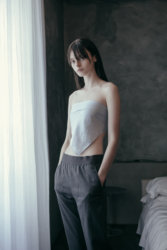You won the First Plinth Public Award this year, could you tell us about the project?
Until 2020 I worked predominantly with taxidermy, stretching animal hides over sculpted forms. Last year, in order to better replicate the iridescence and lustre of some snakes, I relinquished the skin and began painting my own veneers. This has meant I am no longer bound by the perishable nature of skin and can at last diversify into outdoor sculpture. Understand your Audience is a sculpture I made for my exhibition, How to Behave at Home, last year. It involved much experimentation with iridescent transfers used in nail art. Applied to each painted scale individually, they remain transparent but when lit create a rainbow effect over the pattern beneath. This is most successful when lit by the sun as every scale glows with increased intensity. I intend to use this technique for my first public sculpture as the surface will alter depending on the weather.
Where does your passion for dead corpses come from? How did you start working with dead animals?
I don’t have a passion for corpses! Like most humans, I find animals beautiful and they can endlessly inspire. However, I can’t use living animals in my work so I wait for them to die before using their skins or their bodies to cast. This doesn’t mean I don’t prefer them alive. I started to work with them via my interest in Taxidermy. I love the way taxidermy can trick you into thinking something is there that isn’t really there. It’s the 3d troupe l’oeil effect I’m interested in, not death, which is simply a logistical necessity.
Snakes seem to have a significant importance in your work, any particular reason for this?
 https://www.nastymagazine.com/wp-content/uploads/2022/08/PFAHK-201690-HR.jpg
1600
1066
admin
https://www.nastymagazine.com/wp-content/uploads/2015/02/new-logo-basker-WHITE4.png
admin2022-08-05 10:28:422022-08-04 14:05:48Kembra Pfahler / Sound Off
https://www.nastymagazine.com/wp-content/uploads/2022/08/PFAHK-201690-HR.jpg
1600
1066
admin
https://www.nastymagazine.com/wp-content/uploads/2015/02/new-logo-basker-WHITE4.png
admin2022-08-05 10:28:422022-08-04 14:05:48Kembra Pfahler / Sound Off














